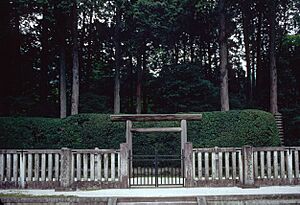Emperor Go-Toba facts for kids
Quick facts for kids Emperor Go-Toba後鳥羽天皇 |
|||||
|---|---|---|---|---|---|

Portrait of Emperor Go-Toba by Fujiwara no Nobuzane, 1221
|
|||||
| Emperor of Japan | |||||
| Reign | September 8, 1183 – February 18, 1198 | ||||
| Coronation | September 4, 1184 | ||||
| Predecessor | Antoku | ||||
| Successor | Tsuchimikado | ||||
| Shōgun | Minamoto no Yoritomo | ||||
| Born | August 6, 1180 Gojō-machi no Tei (五条町の亭), Heian-kyō |
||||
| Died | March 28, 1239 (aged 58) Karita Gosho (苅田御所), Oki Islands, Kamakura shogunate |
||||
| Burial | Ōhara no Misasagi (大原陵) (Kyōto) | ||||
| Spouse |
Fujiwara no Ninshi
(m. 1190) |
||||
| Issue more... |
|
||||
|
|||||
| House | Yamato | ||||
| Father | Emperor Takakura | ||||
| Mother | Fujiwara no Shokushi (Shichijō-in) | ||||
Emperor Go-Toba (後鳥羽天皇, Go-Toba-tennō, August 6, 1180 – March 28, 1239) was the 82nd emperor of Japan. He ruled from 1183 to 1198.
He was named after Emperor Toba. The word go- (後) means "later" or "second". So, he is sometimes called the "Later Emperor Toba" or "Toba the Second."
Contents
Who Was Emperor Go-Toba?
Before he became emperor, his personal name was Takahira-shinnō. He was the fourth son of Emperor Takakura. This made him the grandson of Emperor Go-Shirakawa. His mother was Bōmon Shokushi.
Emperor Go-Toba's Family
Emperor Go-Toba had many children with his empress and other consorts. Two of his sons, Imperial Prince Tamehito and Imperial Prince Morinari, later became emperors themselves.
- Empress (chūgū): Fujiwara no Ninshi/Takako
- First Daughter: Imperial Princess Shōshi (1195–1211)
- Consort: Minamoto no Zaishi/Ariko
- First Son: Imperial Prince Tamehito (later Emperor Tsuchimikado)
- Consort: Fujiwara no Shigeko
- Third Son: Imperial Prince Morinari (later Emperor Juntoku)
- Imperial Prince Masanari (exiled after the Jōkyū War)
- Other children included several imperial princes and princesses. Some became priests or served at important shrines.
Key Events in Go-Toba's Life
Go-Toba became emperor when he was only three years old.
- September 8, 1183: The previous emperor, Antoku, left the capital. Former-Emperor Go-Shirakawa then made Go-Toba the new emperor. This was unusual because the sacred treasures, which are symbols of the emperor's power, were still with Antoku. This was the first time an emperor took the throne without these treasures.
In 1192, Go-Shirakawa died. The first shogunate (a military government) was set up by Minamoto no Yoritomo. This meant the emperor had less real power.
In 1198, Go-Toba stepped down from the throne. His son, Emperor Tsuchimikado, became the new emperor.
Go-Toba continued to have influence as a "cloistered emperor" from 1198 to 1221. This meant he was retired but still tried to guide the government. However, his power was not as strong as earlier cloistered emperors.
During this time, Go-Toba ordered that followers of the Pure Land Buddhist sect be punished. This happened after two of his ladies-in-waiting joined the sect without his permission.
In 1221, Go-Toba tried to take back full power and overthrow the military government. This event is known as the Jōkyū War. Some samurai in Kyoto supported him. But most samurai, especially in the Kantō region, supported the shogunate. Hōjō Masako, the widow of Yoritomo, convinced them that their power would be lost if they didn't support the shogunate. Go-Toba's rebellion failed. His grandson, Emperor Chūkyō, who was only three, was replaced by Go-Horikawa, Go-Toba's nephew.
After the rebellion, Go-Toba was sent away to the Oki Islands. He died and was buried there.
Go-Toba's Talents and Hobbies
Even though his political power was limited, Go-Toba was very talented. He was a skilled calligrapher, painter, musician, poet, and editor. Many of these activities happened after he retired from the throne at age 18. This freedom allowed him to explore his interests.
He loved archery, equestrianism (horse riding), and swordsmanship. He was especially passionate about swords. He invited the best swordsmiths in Japan to his court. He gave them special titles and learned from them. He even became a good swordsmith himself! His support for this art led to Japan's "Golden Age" of bladesmithing. Even today, he is honored as one of the first swordsmiths discussed in sword history.
His most important contribution to literature is the Shin Kokin Wakashū. This is a famous collection of waka poems. Japanese people consider it one of the three most important waka anthologies. Go-Toba ordered its creation and helped edit it. He also held many poetry parties and competitions. He was not just an organizer; he was also a critic who wrote about waka style and other poets.
Even during his exile, he continued to write hundreds of waka poems. He also edited his own version of the Shin Kokinshū. One of his 31-syllable poems was chosen for the popular Hyakunin Isshu anthology.
Eras During Go-Toba's Reign
The years of Emperor Go-Toba's rule are known by different era names or nengō. These are:
See also
Template:KIDDLE XL START  In Spanish: Go-Toba Tennō para niños Template:KIDDLE XL END
In Spanish: Go-Toba Tennō para niños Template:KIDDLE XL END
- Emperor of Japan
- List of Emperors of Japan
- Imperial cult
- Minase Shrine


